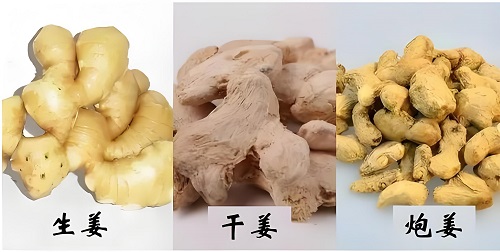We continue our exploration of the incredible medicinal and culinary benefits of ginger, a powerful herb in Traditional Chinese Medicine (TCM).

When ginger undergoes different processing methods, it transforms into dried ginger (Gan Jiang) and roasted ginger (Pao Jiang), each with unique properties and effects. Let’s dive deeper into these variations and their applications in TCM.
Table of Contents
- The Three Types of Ginger
- Differences in Nature and Function
- Medicinal Applications
- The Special Case of Galangal (Gao Liang Jiang)
- Conclusion
1. The Three Types of Ginger
In TCM, ginger is classified into three main types based on its preparation:
- Fresh Ginger (Sheng Jiang) – The raw form commonly used for colds, nausea, and detoxification.
- Dried Ginger (Gan Jiang) – Fresh ginger that has been dried, increasing its warming effects.
- Roasted Ginger (Pao Jiang) – Dried ginger that has been stir-fried or roasted, giving it additional blood-warming and astringent properties.
Each type belongs to different categories in TCM:
- Fresh ginger is categorized as an exterior-releasing herb.
- Dried ginger is classified as an interior-warming herb.
- Roasted ginger is considered a hemostatic (blood-regulating) herb.
2. Differences in Nature and Function
Although all three types of ginger have a spicy taste, their temperature properties and functions differ:
- Fresh Ginger (Sheng Jiang): Warm in nature, moves outward, and helps dispel external cold.
- Dried Ginger (Gan Jiang): Hot in nature, moves inward, and helps warm the interior to dispel internal cold.
- Roasted Ginger (Pao Jiang): Hot but slightly astringent, mainly affecting the blood rather than just the energy circulation.
3. Medicinal Applications
✔️ Fresh Ginger (Sheng Jiang) – Dispels external cold
- Used for wind-cold colds, chills, and detoxification (e.g., seafood poisoning).
✔️ Dried Ginger (Gan Jiang) – Warms the interior and restores yang
- Helps treat internal cold, cold-related diarrhea, and weak digestion.
- Warms the lungs, helping with cold-induced cough and phlegm.
- Second only to Aconite (Fu Zi) in warming power.
✔️ Roasted Ginger (Pao Jiang) – Warms the meridians and stops bleeding
- Strengthens the spleen and stomach while preventing internal bleeding (e.g., for people with weak circulation).
- Helps with cold-induced stomach pain and menstrual cramps.
- Used in cases of spleen yang deficiency, which can lead to poor blood circulation.
4. The Special Case of Galangal (Gao Liang Jiang)
Galangal (Gao Liang Jiang) is another ginger-related herb, but it comes from a different plant in the ginger family.
- Differences: It is not the same as regular ginger!
- Functions:
- Warms the middle and relieves pain.
- Especially effective for stomach pain caused by cold.
- Used for cold-induced vomiting and diarrhea.
In TCM, Galangal is the best choice for relieving cold-related stomach pain.
5. Conclusion
From fresh ginger to dried and roasted ginger, each form offers distinct benefits in TCM. Understanding these differences allows for the precise use of ginger to treat various conditions.
Additionally, galangal, another warming herb in the ginger family, is excellent for stomach cold pain relief.
Ginger is truly a treasure in both the kitchen and medicine cabinet, offering natural healing properties when used correctly. 🌿